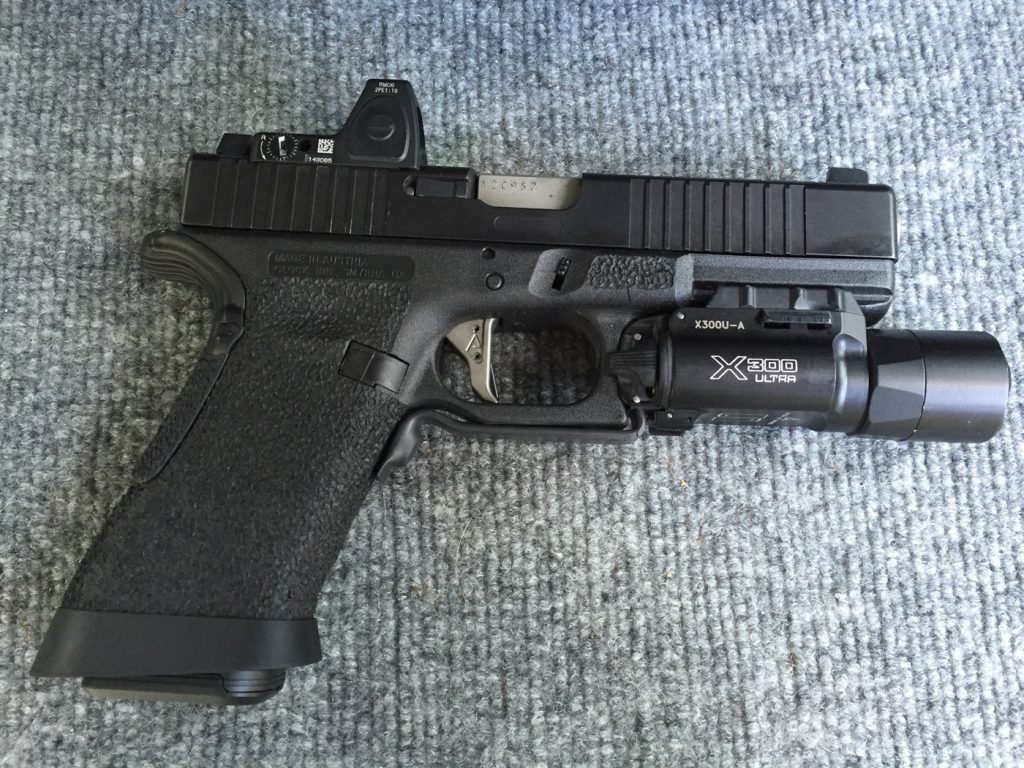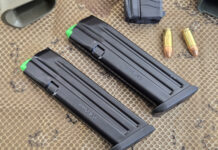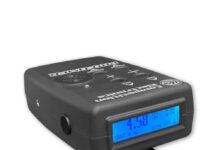Editors Note: When you look at a publication that makes it’s money selling ad space for firearms accessories and modifications and you see repeated articles encouraging gun owners to train and focus on raw skill vs buying the next gadget take note. Bill’s bio speaks for itself and he is the type of man that has had to defend his actions that involved shots actually being fired. Head his words and those of past articles when making your decision to purchase upgrades.
————————————
One of the more common questions asked by my students is whether or not they should modify their defensive firearms. My response to this comes in two parts: first, what are the changes being considered and are they of legitimate value? Second, is the shooter at the point where they can capitalize on the modifications or are they attempting to bypass proper practice with technology? There are numerous additions and enhancements that can improve the handling and use of stock firearm for a skilled shooter. On the other hand, there are some things that are questionable at best, dangerous at worst, and which can actually hurt you.
First and foremost is the question of whether modifications are needed? The unfortunate reality is that many shooters seek to shortcut quality training and proper practice by seeking the latest gizmo that promises to elevate them to master class ability. With limited exceptions, most folks would be better served with a stock firearm, a sizeable supply of ammo, and formal training followed by a regimen of proper practice (for more information on proper practice, please refer to our previous article, “Building the Combat Mindset”). My advice to students is to learn how to use the gun that they have before they start thinking about “fixing” it. Until you’ve shot it, you won’t know what you do or don’t like.
Additionally, there are certain modifications that will be more relevant and useful with greater experience. A new shooter may be able to feel the difference between a stock trigger and a match trigger but will not have the skill to really maximize any advantage conveyed by the better system. For most, a quality firearm out of the box should be sufficient to get started. Seek out quality instruction and follow up with proper practice until the basics of trigger control and sight alignment are firmly established. Fundamentals are fundamental, regardless of the platform – it will always be the shooter and not the song. With a baseline of experience, decisions on when and what to modify will be easier and make more sense.
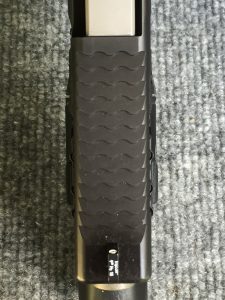
Once the decision has been made to make changes to a defensive firearm, we need to approach those modifications from two perspectives: functional and legal. First, how does the change affect the operation of the firearm and enhance our ability to use it? Second, what effect does the change have towards future court proceedings should we have to use the weapon in a defensive situation?
The first question that needs to be asked is: Why are we making the modification? Almost everyone has heard of the acronym CYA. Most would say that this stands for “Cover your ass.” I use and teach a different meaning, one that I originally learned from Massad Ayoob. For me, CYA means “Can you articulate?” For our purposes here, we should be able to articulate that the modification enhances our ability to use the firearm and thus makes us a more accurate and safer shooter or conveys some other benefit. What we should be looking for are upgrades which increase our performance or improve our ability to interface with the gun. Improved sights or a match grade barrel, for example, can assist with greater practical accuracy while the removal of sharp edges and the application of a more corrosion resistant finish might make the weapon more comfortable to use and carry and decrease maintenance issues.
On the flip side, we want to avoid such changes as excessively light triggers, deactivation of safety devices, and inflammatory embellishments such as engraving “Smile and Wait for Flash” on the muzzle. Such modifications can actually make the weapon less reliable or even unsafe and will be difficult to defend later.
Some will argue against any modifications for defensive firearms, stating that any changes from factory specifications can lead to legal attacks. My feeling on this is that if the work makes us more accurate and precise, this will help us win a gunfight. This is a good thing and something that can be defended later on. Carefully consider what you do to your defensive firearms and be able to explain why you did it.
Finally, make sure to thoroughly test the firearm after customization to make sure that reliability has not been affected and that the weapon functions properly.
Throughout the course of my career, I have endeavored to stick to the principles discussed above when modifying my working guns. From a practical standpoint, I live in north central Florida where it can get very hot and humid. This can have negative effects on guns in terms of corrosion and in manipulation issues due to sweat. I am also a lefty and look to set up my guns to allow efficient, ambidextrous use.
Before undertaking any customization, I spend considerable time on the range, shooting the guns to see if they will be reliable and to determine if anything could be improved. I also carry the guns, because certain issues will manifest themselves in day to day use that one may not encounter during a range session.
Here are two examples of my carry guns, the one that I currently carry on duty today and one from the beginning of my career.
My current primary on-duty handgun is a personally owned/ departmentally approved Glock 17 that has received extensive attention from ATEi (www.ATEiGuns.com). The
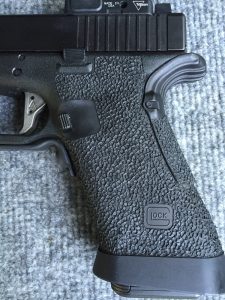
pistol has been cut for a red dot optic, has had the rear serrations on the slide deepened and front serrations added, and has had serrations added to the top of the slide. The serrations are a great help when manipulating the slide, especially with one hand or if the gun is slippery due to water or some other substance. The gun wears a Trijicon RM06 red dot with backup iron sights from Ameriglo. I prefer a front night sight with a plain black rear. The backup irons are essential, in my opinion, for any gun carried on duty or for personal defense, in case the red dot fails. The red dot increases my accuracy potential and significantly extends the range at which I can confidently engage targets.
The frame has been stippled to ensure a firm grip even if my hands are, well, sweaty, muddy, or bloody. Index points were stippled near the
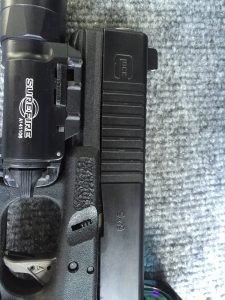
take down lever to provide a spot for my thumb and trigger finger. I have added an extended slide stop and magazine release from TangoDown, as they help me manipulate the gun, particularly being left-handed. The gun wears a magazine well from Sentinel Designs to aid in reloads (now produced by Raven Concealment as the Freya). I have attached a Surefire X300 Ultra weapon light with a DG switch. The light always rides on the gun and allows for target discrimination in low light.
Finally, I have upgraded the trigger to the Agency Arms flat faced trigger. I selected this trigger for two primary reasons. First, the flat shoe has a much improved feel that helps me press the trigger straight to the rear. Secondly, the other parts to the trigger are stock, albeit polished. The springs are factory weight and all safeties are maintained. I think that people get too wrapped around the axle with triggers. What I look for is a trigger that I can manage. I don’t need perfect; I am happy with good enough.
When I started in law enforcement, the trend towards double action/ single action semi-automatics was in full swing. I started my career with an issued Smith and Wesson 4506 but later transitioned to a personally owned, departmentally approved S&W 4576, which is the mid-sized, decocker only version of the larger 4506. I found that this gun carried better but still gave me full size performance. There were, however, several things that I wanted improved and, for the work, I sent the gun to Novak’s .45 Shop.
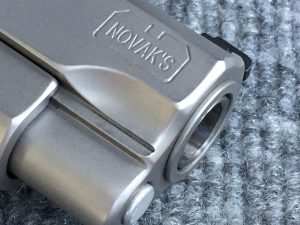 Novak’s performed a carry bevel, removing all sharp edges and making the pistol more comfortable to shoot and carry. The action was smoothed, resulting in a better double action press that was still within factory specs. The barrel throat was polished to enhance reliable feeding of different types of ammunition.
Novak’s performed a carry bevel, removing all sharp edges and making the pistol more comfortable to shoot and carry. The action was smoothed, resulting in a better double action press that was still within factory specs. The barrel throat was polished to enhance reliable feeding of different types of ammunition.
This was before weapon lights were common, particularly for handguns, but I did have night sights installed as I was working midnights at the time and felt they would aid in low light. Finally, much later, I sent the grip to David Bowie at Bowie Tactical Concepts and had it textured for an improved gripping surface.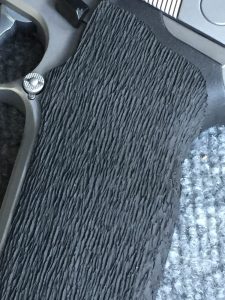
In both cases, the modifications performed are things that I can clearly articulate as improving my ability to control, manage, and carry the guns. Nothing fancy or flashy, just basic modifications to enhance performance.
Many defensive firearms can benefit from customization. Sights, triggers, and new finishes can significantly enhance performance and durability. Just take the time to figure out what you actually need and can articulate. This will save time and money and can avoid creating issues down the road. Finally, never forget that technology cannot and will not supplant skills. The only sure way to become an effective shooter is to invest the time on the range with quality instruction and proper practice.
Source Article from http://248shooter.com/index.php/modifying-defensive-firearm/

